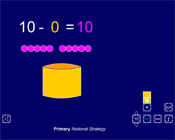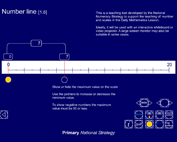Consolidation and practice
These resources are to support children in guided or independent work. Roll over the highlighted resources for a description.
Number facts

This interactive teaching program (ITP) is an ICT-based tool to support the exploration of corresponding addition and subtraction facts. Number facts ITP allows the child or teacher to display up to 20 counters, select some to represent an addition or subtraction number sentence, and drag counters into a container to demonstrate a subtraction.
Number line

This interactive teaching program (ITP) is an ICT-based tool to support the exploration of number. Number line ITP allows the child or teacher to display a range of numbers from minus 50 up to 500. Children can estimate a number on the number line, explore the concept of difference between two given numbers and demonstrate their calculation strategies.
Opportunities to use and apply
- number problems and puzzles, e.g. The number in each brick is the sum of the two bricks just below it. Complete these walls. How many ways can you find to complete the second pyramid?


- problems from the
 Mathematical challenges booklet | 920KB
Mathematical challenges booklet | 920KB  , e.g. problems 31, 32 and 35.
, e.g. problems 31, 32 and 35.
Confirming learning
- Write one of these numbers into each box to make a correct sum. 14, 7, 9, 16, 5
 =
=  +
+ 
- Which addition fact could you use to find the answer to
12 − 4?
 −
−  = 9
= 9 , 17 + 8 =
, 17 + 8 =  ,
, 
 Knowing and using number facts
Knowing and using number facts




